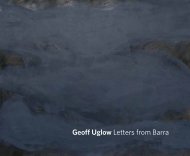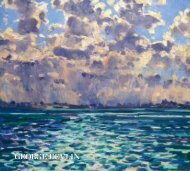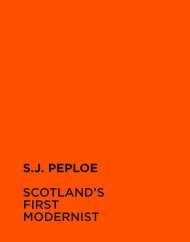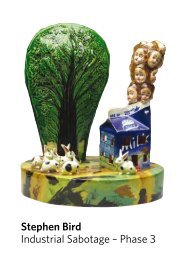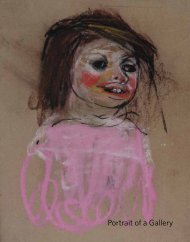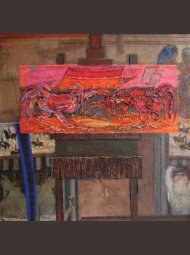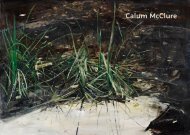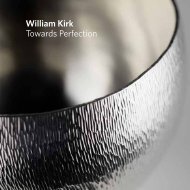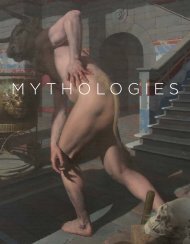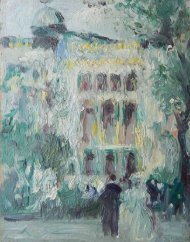Download a PDF of the exhibition catalogue - The Scottish Gallery
Download a PDF of the exhibition catalogue - The Scottish Gallery
Download a PDF of the exhibition catalogue - The Scottish Gallery
Create successful ePaper yourself
Turn your PDF publications into a flip-book with our unique Google optimized e-Paper software.
By <strong>the</strong> time <strong>of</strong> <strong>the</strong> artist’s death in 1935 James Caw had come to recognise Peploe as one <strong>of</strong> Scotland’s greatest painters.<br />
Caw was <strong>the</strong> biographer <strong>of</strong> his fa<strong>the</strong>r-in-law William McTaggart and wrote a History <strong>of</strong> <strong>Scottish</strong> Art, published in 1908.<br />
He became <strong>the</strong> director <strong>of</strong> <strong>the</strong> <strong>Scottish</strong> National <strong>Gallery</strong> and <strong>the</strong> <strong>Scottish</strong> National Portrait <strong>Gallery</strong> from 1907–1930.<br />
When he reviewed Peploe’s first <strong>exhibition</strong> in 1903 his praise was heavily qualified; he identified a ‘perverse taste for<br />
<strong>the</strong> ugly or <strong>the</strong> bizarre in figure and landscape’ 1 and a lack <strong>of</strong> subtlety <strong>of</strong> vision. Certainly Peploe’s early work is bold<br />
and his subjects not chosen for <strong>the</strong>ir inherent beauty; even <strong>The</strong> Lobster (which Caw singles out for particular praise) is a<br />
difficult subject; an admirable lunch and a complex, fascinating creature but certainly a challenge to <strong>the</strong> painter. Peploe<br />
has made out <strong>of</strong> it one <strong>of</strong> his masterpieces.<br />
Peploe admired seventeenth century Dutch painting and had made a study trip to Holland in <strong>the</strong> mid-1890s 2<br />
and that still life tradition, which includes specialist painters <strong>of</strong> <strong>the</strong> pr<strong>of</strong>usion <strong>of</strong> <strong>the</strong> fishmonger’s table, is acknowledged.<br />
His composition however is uncluttered, much closer in spirit to Chardin or Manet. This was Peploe’s first <strong>exhibition</strong><br />
and <strong>the</strong> obsessive care he took in <strong>the</strong> preparations (including painting and repainting a frieze in one <strong>of</strong> <strong>the</strong> rooms)<br />
indicates a personality trait and a recognition after many years <strong>of</strong> study and preparation that at <strong>the</strong> age <strong>of</strong> thirty-three<br />
this <strong>exhibition</strong> would launch his career as an exhibiting artist.<br />
Peploe’s skill was in perfect balance with his confidence: <strong>the</strong> bone handle <strong>of</strong> <strong>the</strong> knife is made up <strong>of</strong> three<br />
brushstrokes and every mark is assured and perfectly placed. <strong>The</strong> beautifully graded tones <strong>of</strong> <strong>the</strong> table-top merge into<br />
background: olive to a black enriched with burnt-sienna. <strong>The</strong> harmony <strong>of</strong> his arrangement, a loose rhombus made <strong>of</strong><br />
lobster, knife, plate and lemon is perfectly lit to allow a maximum impact <strong>of</strong> colour and tonal contrast. <strong>The</strong> vertically<br />
placed signature in lobster-colour seems a self-consciously stylish touch: like a piece <strong>of</strong> oriental calligraphy – but it is<br />
also an essential part <strong>of</strong> his composition.<br />
1 Sir James Caw, ‘Studio Talk – Edinburgh’, <strong>The</strong> Studio (Vol XXX, 1904), p.161<br />
2 Guy Peploe, S.J. Peploe, (Mainstream, Edinburgh, 2000), p.16<br />
58



